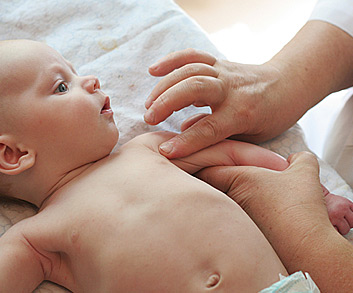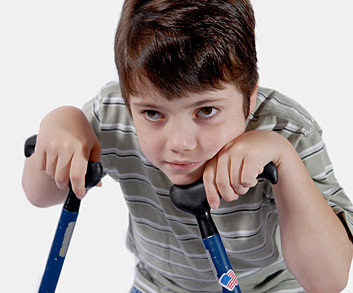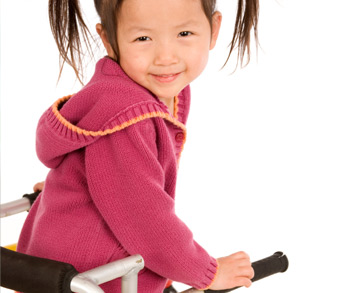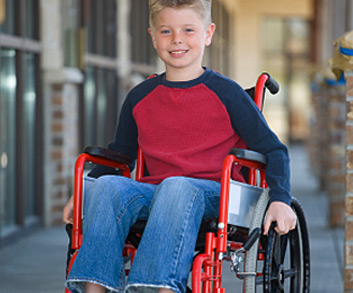Internal mini form
Contact Us Today
Several Cerebral Palsy classification systems exist today to define the type and form of Cerebral Palsy an individual has. The classification is complicated by the wide range of clinical presentations and degrees of activity limitation that exist. Knowing the severity, location and type of Cerebral Palsy your child has will help to coordinate care and fund treatment.
Why so confusing?
“What type of Cerebral Palsy does my child have? And, why does one doctor classify my child’s Cerebral Palsy one way, while the other doctor labels it another way?”
Classification preference changes based on the intended use
Professionals who specialize in the treatment of Cerebral Palsy approach the condition from a number of different vantage points. An orthopedic surgeon requires a definition of the limbs affected and the extent of impairment in order to prescribe treatment.
Neurosurgeons and neuroradiologists, on the other hand, are more concerned with the cause of the brain damage and descriptors for imposing white and gray matter so as to determine the type of brain injury or brain malformation. They are also concerned with diagnosing the extent and severity level of the child’s Cerebral Palsy.
At first, a parent may be concerned with the severity level classification – mild, moderate or severe – in order to better understand the seriousness of the child’s impairment or disability. When meeting with the child’s pediatrician or physical therapist, it is useful to understand the topographical distribution of the impairment – the limbs and the sides of the body affected by brain damage. It is also important to clarify whether the child has a plegia (paralysis) or paresis (weakened) condition.
Government agencies and school administrators may be more concerned with classification systems that coincide with their ability to qualify a child for special education supports and services. Only then can they plan and administer and allocate educational supports to the child.
Researchers are interested in utilizing a universally accepted classification system, such as the Gross Motor Function Classification System, or GMFCS, to increase consistency in studies worldwide and to expand the ability to build knowledge around prevalence, life expectancy, societal impact, prevention measures and educational awareness.
The move toward a universal classification system
For these reasons, many Cerebral Palsy classification systems are used today. Over the last 150 years, the definition of Cerebral Palsy has evolved and changed as new medical discoveries contributed to growing knowledge of the condition. Although a myriad of classifications – used differently and for many purposes – exists today, those involved in Cerebral Palsy research are working toward a universally accepted classification system.
Because of the diversity of classification systems, parents may want to document different terms doctors use in Cerebral Palsy diagnosis. In addition, parents should also maintain home health records documenting associated impairments, anatomic and radiation findings, as well as causation and timing. MyChild™ has developed the Cerebral Palsy Diagnosis Checklist and the Cerebral Palsy Risk Factor Checklist for this purpose.
What types of Cerebral Palsy are there?
Below are the most commonly used classification systems understood and used by qualified practitioners.
- Classification based on severity level
- Classification based on topographical distribution
- Classification based on motor function
- Classification based on gross motor function classification system
These are detailed below.
Classification based on severity level
Cerebral Palsy is often classified by severity level as mild, moderate, severe, or no CP. These are broad generalizations that lack a specific set of criteria.

Even when doctors agree on the level of severity, the classification provides little specific information, especially when compared to the GMFCS. Still, this method is common and offers a simple method of communicating the scope of impairment, which can be useful when accuracy is not necessary.
Mild – Mild Cerebral Palsy means a child can move without assistance; his or her daily activities are not limited.
Moderate – Moderate Cerebral Palsy means a child will need braces, medications, and adaptive technology to accomplish daily activities.
Severe – Severe Cerebral Palsy means a child will require a wheelchair and will have significant challenges in accomplishing daily activities.
No CP – No CP means the child has Cerebral Palsy signs, but the impairment was acquired after completion of brain development and is therefore classified under the incident that caused the Cerebral Palsy, such as traumatic brain injury or encephalopathy.
Classification based on topographical distribution
Topographical classification describes body parts affected. The words are a combination of phrases combined for one single meaning. When used with Motor Function Classification System, it provides a description of where and to what extent a child is affected by Cerebral Palsy. This method is useful in ascertaining treatment protocol.
- Paresis means weakened
- Plegia/Plegic means paralyzed
The prefixes and root words are combined to yield the topographical classifications commonly used in practice today.

Monoplegia/monoparesis means only one limb is affected. It is believed this may be a form of hemiplegia/hemiparesis where one limb is significantly impaired.
Diplegia/diparesis usually indicates the legs are affected more than the arms; primarily affects the lower body.
Hemiplegia/hemiparesis indicates the arm and leg on one side of the body are affected.
Paraplegia/paraparesis means the lower half of the body, including both legs, is affected.
Triplegia/triparesis indicates three limbs are affected. This could be both arms and a leg, or both legs and an arm. Or, it could refer to one upper and one lower extremity and the face.
Double hemiplegia/double hemiparesis indicates all four limbs are involved, but one side of the body is more affected than the other.
Tetraplegia/tetraparesis indicates that all four limbs are involved, but three limbs are more affected than the fourth.
Quadriplegia/quadriparesis means that all four limbs are involved.
Pentaplegia/pentaparesis means all four limbs are involved, with neck and head paralysis often accompanied by eating and breathing complications

Classification based on motor function
The brain injury that causes Cerebral Palsy affects motor function, the ability to control the body in a desired matter. Two main groupings include spastic and non-spastic. Each has multiple variations and it is possible to have a mixture of both types.
Spastic Cerebral Palsy is characterized by increased muscle tone.
Non-spastic Cerebral Palsy will exhibit decreased or fluctuating muscle tone.
Motor function classification provides both a description of how a child’s body is affected and the area of the brain injury. Using motor function gives parents, doctors, and therapists a very specific, yet broad, description of a child’s symptoms, which helps doctors choose treatments with the best chance for success.
Muscle tone
Many motor function terms describe Cerebral Palsy’s effect on muscle tone and how muscles work together. Proper muscle tone when bending an arm requires the bicep to contract and the triceps to relax. When muscle tone is impaired, muscles do not work together and can even work in opposition to one another.
Two terms used to describe muscle tone are:
Hypertonia/Hypertonic — increased muscle tone, often resulting in very stiff limbs. Hypertonia is associated with spastic Cerebral Palsy
Hypotonia/Hypotonic — decreased muscle tone, often resulting in loose, floppy limbs. Hypotonia is associated with non-spastic Cerebral Palsy
Two classifications by motor function:
pyramidal (spastic) and extrapyramidal (non-spastic)
When referring to location of the brain injury, spastic and non-spastic Cerebral Palsy is referred to in the medical community as pyramidal and extrapyramidal Cerebral Palsy.
Pyramidal, or spastic Cerebral Palsy
The pyramidal tract consists of two groups of nerve fibers responsible for voluntary movements. They descend from the cortex into the brain stem. In essence, they are responsible for communicating the brain’s movement intent to the nerves in the spinal cord that will stimulate the event. Pyramidal Cerebral Palsy would indicate that the pyramidal tract is damaged or not functioning properly.
Extrapyramidal Cerebral Palsy indicates the injury is outside the tract in areas such as the basal ganglia, thalamus, and cerebellum. Pyramidal and extrapyramidal are key components to movement impairments.
Spasticity implies increased muscle tone. Muscles continually contract, making limbs stiff, rigid, and resistant to flexing or relaxing. Reflexes can be exaggerated, while movements tend to be jerky and awkward. Often, the arms and legs are affected. The tongue, mouth, and pharynx can be affected, as well, impairing speech, eating, breathing, and swallowing.
Spastic Cerebral Palsy is hypertonic and accounts for 70% to 80% of Cerebral Palsy cases. The injury to the brain occurs in the pyramidal tract and is referred to as upper motor neuron damage.
The stress on the body created by spasticity can result in associated conditions such as hip dislocation, scoliosis, and limb deformities. One particular concern is contracture, the constant contracting of muscles that results in painful joint deformities.
Spastic Cerebral Palsy is often named in combination with a topographical method that describes which limbs are affected, such as spastic diplegia, spastic hemiparesis, and spastic quadriplegia.
Extrapyramidal, or non-spastic Cerebral Palsy
Non-spastic Cerebral Palsy is decreased and/or fluctuating muscle tone. Multiple forms of non-spastic Cerebral Palsy are each characterized by particular impairments; one of the main characteristics of non-spastic Cerebral Palsy is involuntary movement. Movement can be slow or fast, often repetitive, and sometimes rhythmic. Planned movements can exaggerate the effect – a condition known as intention tremors. Stress can also worsen the involuntary movements, whereas sleeping often eliminates them.
An injury in the brain outside the pyramidal tract causes non-spastic Cerebral Palsy. Due to the location of the injury, mental impairment and seizures are less likely. Non-spastic Cerebral Palsy lowers the likelihood of joint and limb deformities. The ability to speak may be impaired as a result of physical, not intellectual, impairment.
Non-spastic Cerebral Palsy is divided into two groups, ataxic and dyskinetic. Together they make up 20% of Cerebral Palsy cases. Broken down, dyskinetic makes up 15% of all Cerebral Palsy cases, and ataxic comprises 5%.
Ataxic/ataxia
Ataxic Cerebral Palsy affects coordinated movements. Balance and posture are involved. Walking gait is often very wide and sometimes irregular. Control of eye movements and depth perception can be impaired. Often, fine motor skills requiring coordination of the eyes and hands, such as writing, are difficult. Does not produce involuntary movements, but instead indicates impaired balance and coordination
Dyskinetic
Dyskinetic Cerebral Palsy is separated further into two different groups; athetoid and dystonic.
Athetoid Cerebral Palsy includes cases with involuntary movement, especially in the arms, legs, and hands.
Dystonia/Dystonic Cerebral Palsy encompasses cases that affect the trunk muscles more than the limbs and results in fixed, twisted posture.
Because non-spastic Cerebral Palsy is predominantly associated with involuntary movements, some may classify Cerebral Palsy by the specific movement dysfunction, such as:
Athetosis — slow, writhing movements that are often repetitive, sinuous, and rhythmic
Chorea — irregular movements that are not repetitive or rhythmic, and tend to be more jerky and shaky
Chorea — irregular movements that are not repetitive or rhythmic, and tend to be more jerky and shaky
Choreoathetoid — a combination of chorea and athetosis; movements are irregular, but twisting and curving
Dystonia — involuntary movements accompanied by an abnormal, sustained posture
Mixed
A child’s impairments can fall into both categories, spastic and non-spastic, referred to as mixed Cerebral Palsy. The most common form of mixed Cerebral Palsy involves some limbs affected by spasticity and others by athetosis.

Classification based on Gross Motor Function Classification System
Gross Motor Function Classification System, or GMFS, uses a five-level system that corresponds to the extent of ability and impairment limitation. A higher number indicates a higher degree of severity. Each level is determined by an age range and a set of activities the child can achieve on his or her own.
The GMFCS is a universal classification system applicable to all forms of Cerebral Palsy. Using GMFCS helps determine the surgeries, treatments, therapies, and assistive technology likely to result in the best outcome for a child. Additionally, the GMFCS is a powerful system for researchers; it improves data collection and analysis and hence result in better understanding and treatment of Cerebral Palsy.
The GMFCS addresses the goal set by organizations such as the World Health Organization, or WHO, and the Surveillance of Cerebral Palsy in Europe, or SCPE, which advocate for a universal classification system that focuses on what a child can accomplish, as opposed to the limitations imposed by his or her impairments.
This system is useful to parents and caretakers as a developmental guideline which takes into consideration the child’s motor impairment. It assigns a classification level (GMFCS Level 1 – 5). The parent is then able to understand motor impairment abilities over time, as the child progresses in age.
To best utilize the GMFCS, it is often combined with other classification systems that define the extent, location, and severity of impairment. It is also recommended to document upper extremity function and speech impairments.
How is GMFCS used?
The GMFCS uses head control, movement transition, walking, and gross motor skills such as running, jumping, and navigating inclined or uneven surfaces to define a child’s accomplishment level. The goal is to present an idea of how self-sufficient a child can be at home, at school, and at outdoor and indoor venues.
When the child fits in multiple levels, the lower of the two classification levels is chosen. The GMFCS classification system recognizes that children with impairments have age-appropriate developmental factors. GMFCS is able to chart by age group (0-2; 2-4; 4-6; 6-12; and 12-18) a developmental guideline appropriate for the assigned GMFCS level. It emphasizes sitting, movement transfers and mobility, charting independence and reliance on adaptive technology.
Cerebral Palsy is often classified by severity level as mild, moderate, severe, or no CP. These are broad generalizations that lack a specific set of criteria. Even when doctors agree on the level of severity, the classification provides little specific information, especially when compared to the GMFCS. Still, this method is common and offers a simple method of communicating the scope of impairment, which can be useful when accuracy is not necessary.
GMFCS classification levels
GMFCS Level I – walks without limitations.
GMFCS Level II – walks with limitations. Limitations include walking long distances and balancing, but not as able as Level I to run or jump; may require use of mobility devices when first learning to walk, usually prior to age 4; and may rely on wheeled mobility equipment when outside of home for traveling long distances.
GMFCS Level III – walks with adaptive equipment assistance. Requires hand-held mobility assistance to walk indoors, while utilizing wheeled mobility outdoors, in the community and at school; can sit on own or with limited external support; and has some independence in standing transfers.
GMFCS Level IV – self-mobility with use of powered mobility assistance. Usually supported when sitting; self-mobility is limited; and likely to be transported in manual wheelchair or powered mobility.
GMFCS Level V – severe head and trunk control limitations. Requires extensive use of assisted technology and physical assistance; and transported in a manual wheelchair, unless self-mobility can be achieved by learning to operate a powered wheelchair.
How can I obtain a copy of the expanded and revised GMFCS Classification System?
More information about the GMFCS Classification System is available at:
CanChild Centre for Childhood Disability Research website at McMaster University
A pdf of the GMFCS Classification System is made available at:
The GMFCS Classification System is provided by:
GMFCS – E & R © Robert Palisano, Peter Rosenbaum, Doreen Bartlett, Michael Livingston, 2007, CanChild Centre for Childhood Disability Research, McMaster University.
RESOURCES
Types and Forms of Cerebral Palsy
For other sources with general information on the types and forms of Cerebral Palsy, MyChild™ recommends the following:
- American Academy for Cerebral Palsy and Developmental Medicine, or AACDM
- Alfred I duPont Hospital for Children
- National Institute of Neurological Disorders and Stroke, or NINDS
- Cerebral Palsy International Research Foundation, or CPIRF
- Surveillance of Cerebral Palsy, or SCPE
- World Health Organization – Classifications
- World Health Organization – Noncommunicable Diseases and Mental Health





